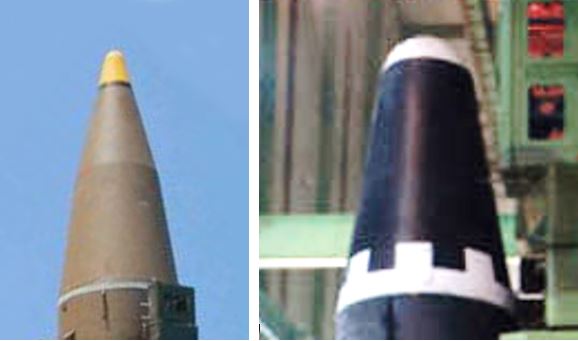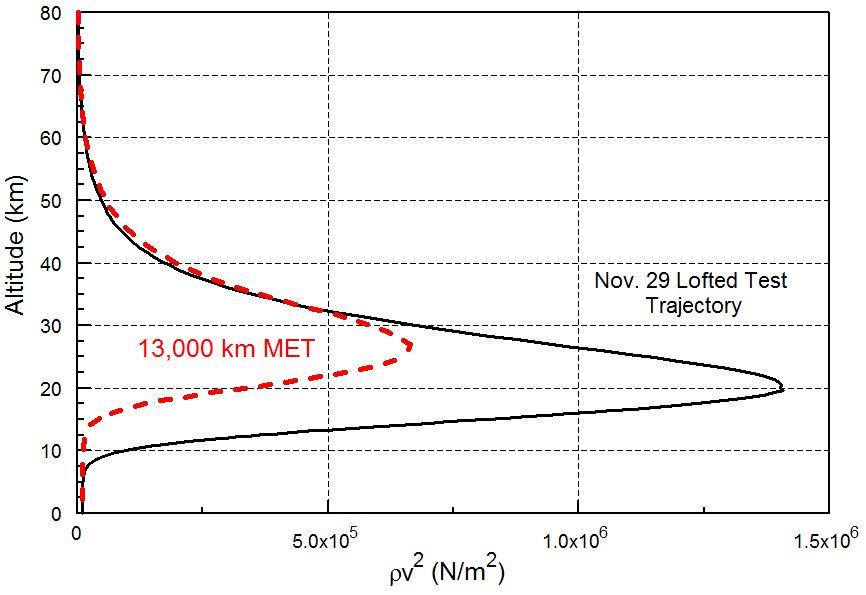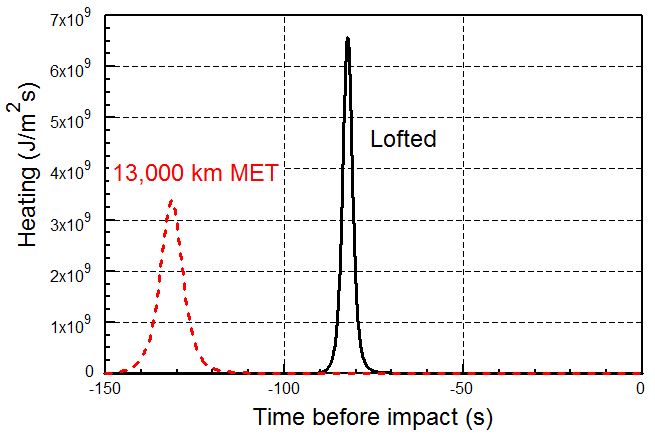Photos of the Hwasong-15 missile North Korea launched on its November 29 test suggest it is considerably more capable than the long-range missiles it tested in July. This missile’s length and diameter appear to be larger by about 10 percent than July’s Hwasong-14. It has a significantly larger second stage and a new engine in the first stage that appears to be much more powerful.
While we are still working through the details, this strongly implies that North Korea could use this missile to carry a nuclear warhead to cities throughout the United States. A final possible barrier people are discussing is whether Pyongyang has been able to develop a reentry vehicle that can successfully carry a warhead through the atmosphere to its target, while protecting the warhead from the very high stresses and heat of reentry.
Here are my general conclusions, which I discuss below:
- North Korea has not yet demonstrated a working reentry vehicle (RV) on a trajectory that its missiles would fly if used against the United States.
- However, there doesn’t appear to be a technical barrier to building a working RV, and doing so is not likely to be a significant challenge compared to what North Korea has already accomplished in its missile program.
- From its lofted tests, North Korea can learn significant information needed for this development, if it is able to collect this information.
- While the United States put very significant resources into developing sophisticated RVs and heatshields, as well as extensive monitoring equipment to test them, that effort was to develop highly accurate missiles, and is not indicative of the effort required by North Korea to develop an adequate RV to deliver a nuclear weapon to a city.
The Hwasong-15 RV
When the photos appeared after North Korea’s November 29 missile launch, I was particularly interested to see the shape of the front of the missile, which gives information about the reentry vehicle (RV). The RV contains the warhead and protects it on its way to the ground. It appears the Hwasong-15 is carrying an RV that is considerably wider and blunter than that on the Hwasong-14 (Fig. 1).

Fig. 1. The RVs for the Hwasong-14 (left) and Hwasong-15 (right), roughly to scale. (Source: KCNA)
This fact has several implications. A blunter RV can clearly accommodate a larger diameter warhead, and the warhead can sit farther forward toward the nose of the RV. This moves the center of mass forward and makes the RV more stable during reentry. (This drawing shows how the cylindrical nuclear weapon in the US Titan RV, which was roughly the same size and shape, although much heavier, than the Hwasong-15 RV may be.)
A blunter nose on the Hwasong-15 RV also helps protect it from high atmospheric forces and heating during reentry. Here’s why:
As the RV enters the atmosphere, drag due to the air acts as a braking force to slow it down, and that braking force puts stress on the warhead. At the same time, much of the kinetic energy the RV loses as it slows down shows up as heating of the air around the RV. Some of that heat is transferred from the air to the RV, and therefore heats up the warhead. If the stress and/or heating are too great they can damage the RV and the warhead inside it.
A blunter RV has higher drag and slows down in the thin upper parts of the atmosphere more than does a slender RV, which continues at high speed into the thick lower parts of the atmosphere. This results in significantly less intense stress and heating on the blunter RV. In addition to that, a blunt nose creates a broad shock wave in front of the RV that also helps keep the hot air from transferring its heat to the RV.

Fig. 2. This shows two low-drag RVs being placed on a Minuteman III missile, which can carry three RVs. (Source: US Air Force).
A rough estimate shows that if the RVs had the same mass and flew on the same trajectory, the peak atmospheric forces and heating experienced by an RV similar in shape to the Hwasong-14 nosecone in Fig. 1 would be roughly four or more times as great as that experienced by a blunter Hwasong-15 RV; those on a modern US RV, like that on the Minuteman III missile (Fig. 2), might be 20 times as large as on the Hwasong-15 RV.
The tradeoff of having a blunt warhead is that when the RV travels more slowly through the atmosphere it reduces its accuracy. In order to get very high accuracy with its missiles, the United States spent a tremendous amount of effort developing highly sophisticated heatshields that could withstand the heating experienced by a slender, low-drag RV.
For North Korea, the decrease in accuracy due to a blunt RV is not particularly important. The accuracy of its long-range missiles will likely be tens of kilometers. That means that it would not use its missiles to strike small military targets, but would instead strike large targets like cities. For a large target like that, the reduction in accuracy due to a blunt RV is not significant.
What could North Korea learn from its recent test?
Press stories report US officials as saying that the reentry vehicle on North Korea’s November 29 test “had problems” and “likely broke up” during reentry. If true, this implies that the RV used on this flight could not withstand the strong drag forces as the RV reached low altitudes.
It’s worth noting that the drag forces on the RV during reentry on the lofted trajectory would be more than twice as great as they would be on a standard trajectory of 13,000 km range flown by the same missile (Fig. 3). This is because on the flatter trajectory, the RV flies through a longer path of thin air and therefore slows down more gently than on the lofted trajectory. It is therefore possible the RV might survive if flown on a standard trajectory, but North Korea has not yet demonstrated that it would.
However, given the estimated capability of the Hwasong-15 missile, North Korea appears to have the option of strengthening the RV, which would increase its mass somewhat, and still be able to deliver a warhead to long distances.

Fig. 3. This figure shows the atmospheric forces on the RV with altitude as it reenters, for the highly lofted test on November 29 (black curve) compared to the same missile flying a 13,000 km standard trajectory (a minimum-energy trajectory, MET). The horizontal axis plots the product of the atmospheric density and square of the RV speed along its trajectory, which is proportional to the drag force on the RV. The calculations in all these figures assume a ballistic coefficient of the RV of 100 lb/ft2 (5 kN/m2). Increasing the ballistic coefficient will increase the magnitude of the forces and move the peaks to somewhat lower altitudes, but the comparative size of the curves will remain similar.
The situation is similar with heating of the RV. The last three columns of Fig. 4 compare several measures of the heating experienced by the RV on the lofted November 29 test to what would be experienced by the same RV on a 13,000 km-range missile on a standard trajectory (MET).

Fig. 4. A comparison of RV forces and heating on the November 29 test and on a 13,000 km-range trajectory, assuming both missiles have the same RV and payload. A discussion of these quantities is given in the “Details” section below.
These estimates show that the maximum heating experienced on the lofted trajectory would be about twice that on a standard trajectory, but that total heat absorbed by the RV on the two trajectories would be roughly the same. Because the heating occurs earlier on the RV on the standard trajectory than on the lofted trajectory, that heat has about 130 seconds to diffuse through the insulation of the RV to the warhead, while the heat on the lofted trajectory diffuses for about 80 seconds (Fig. 5). This somewhat longer time for “heat soak” can increase the amount of heat reaching the warhead, but North Korea would put insulation around the warhead inside the RV, and the heat transfer through insulators that North Korea should have access to is low enough that this time difference is probably not significant.

Fig. 5: This figure shows how the heating rate of the RV surface varies with time before impact on the lofted and standard trajectory. The areas under the curves are proportional to the total heat absorbed by the RV, and is only about 20% larger for the MET. The vertical axis plots the product of the atmospheric density and the cube of the RV speed along its trajectory, which is proportional to the heating rate on the RV.
Fig. 6 shows heating on the two trajectories with altitude.

Fig. 6. This figure shows the heating of the RV with altitude as it reenters.
These results show that if North Korea were able to demonstrate that its RV could survive the peak drag forces and heating on a lofted trajectory, it should also be able to survive those on a standard trajectory. As noted above, the estimated capability of the Hwasong-15 missile suggests North Korea would be able to increase the structural strength of the RV and its heat shielding and still be able to deliver a warhead to long distances.
There is still some question about what information North Korea may actually be getting from its tests. One advantage of testing on highly lofted trajectories that fall in the Sea of Japan is that the RV can presumably radio back data to antennae in North Korea for most of the flight. However, because of the curvature of the Earth, an antenna on the ground in North Korea would not be able to receive signals once the RV dropped below about 80 km altitude at a distance of 1000 km. To be able to track the missile down to low altitudes it would likely need a boat or plane in the vicinity of the reentry point.
Some details
The rate of heat transfer per area (q) is roughly proportional to ρV3, where ρ is the atmospheric density and V is the velocity of the RV through the atmosphere. Since longer range missiles reenter at higher speeds, the heating rate increases rapidly with missile range. The total heat absorbed (Q) is the integral of q over time during reentry. Similarly, forces due to atmospheric drag are proportional to ρV2, and also increase rapidly with missile range.
The calculations above assume a ballistic coefficient of the RV equal to 100 lb/ft2 (5 kN/m2). The ballistic coefficient β = W/CdA (where W is the weight of the RV, Cd is its drag coefficient, and A is its cross-sectional area perpendicular to the air flow) is the combination of parameters that determines how atmospheric drag reduces the RV’s speed during reentry. The drag and heating values in the tables roughly scale with β. A large value of β means less atmospheric drag so the RV travels through the atmosphere at higher speed. That increases the accuracy of the missile but also increases the heating. The United States worked for many years to develop RVs with special coatings that allowed them to have high β and therefore high accuracy, but could also withstand the heating under these conditions.
Based on the shape of the front of the Hwasong-15, I estimate that the drag coefficient Cd of its RV is 0.35-0.4. That value gives β in the range of 100-150 lb/ft2 (5-7 kN/m2) for an RV mass of 500-750 kg. The drag coefficient of an RV similar in shape to the front of the Hwasong-14 is about 0.15.
Updated 12/8/17.
